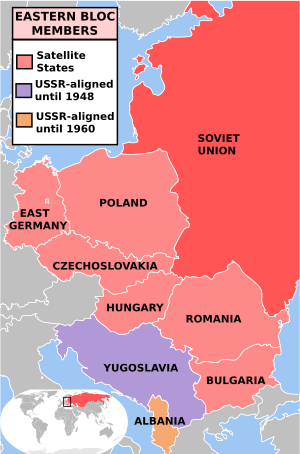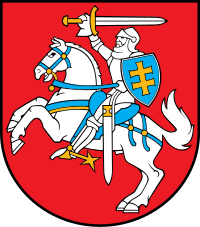January Events (Lithuania)
The January Killings (Lithuanian: Sausio žudynės) took place in Lithuania between 11 and 13 January 1991 in the aftermath of the Act of the Re-Establishment of the State of Lithuania. As a result of Soviet military actions, 14 civilians were killed and 702 were injured.[2] The events were centered in its capital, Vilnius, along with related actions in its suburbs and in the cities of Alytus, Šiauliai, Varėna, and Kaunas.
| January Killings Lithuanian: Sausio žudynės | |||||||
|---|---|---|---|---|---|---|---|
| Part of Revolutions of 1989, Singing Revolution, and Dissolution of the Soviet Union | |||||||
 A man with a Lithuanian flag in front of a Soviet tank, 13 January 1991 | |||||||
| |||||||
| Belligerents | |||||||
|
|
| ||||||
| Commanders and leaders | |||||||
|
|
| ||||||
| Casualties and losses | |||||||
|
14 civilians killed 1 civilian died due to heart attack 702 injured | 1 KGB soldier (friendly fire) | ||||||
| Eastern Bloc | |||||||
|---|---|---|---|---|---|---|---|
 | |||||||
|
Allied states
|
|||||||
|
Related organizations |
|||||||
|
Dissent and opposition
|
|||||||
Background
The Baltic states, including Lithuania, were forcibly annexed by the Soviet Union in 1940. This move was never recognized by Western powers. See Occupation of the Baltic states.
The Lithuanian Republic declared independence from the Soviet Union on 11 March 1990 and thereafter underwent a difficult period of emergence. During March–April 1990 the Soviet Airborne Troops (VDV) occupied buildings of the Political Education and the Higher Party School where later encamped the alternative Lithuanian Communist Party, on the CPSU platform.
The Soviet Union imposed an economic blockade between April and late June.[3] Economic and energy shortages undermined public faith in the newly restored state. The inflation rate reached 100% and continued to increase rapidly. In January 1991 the Lithuanian government was forced to raise prices several times and was used for organization of mass protests of the so-called "Russophone population".[4]
During the five days preceding the killings, Soviet, Polish, and other workers at Vilnius factories protested the government's consumer goods price hikes and what they saw as ethnic discrimination.[5] (According to Human Rights Watch, the Soviet government had mounted a propaganda campaign designed to further ethnic strife.)[3]
In protection of the rallied Russophone population, the Soviet Union sent elite armed forces and special service units.[4]
On 8 January the conflict between Chairman of the Parliament Vytautas Landsbergis and the more pragmatic Prime Minister Kazimira Prunskienė culminated in her resignation.[3] Prunskienė met with Soviet Union President Mikhail Gorbachev on that day. He refused her request for assurances that military action would not be taken.[3]
On the same day the Yedinstvo movement organized a rally in front of the Supreme Council of Lithuania. Protesters tried to storm the parliament building but were driven away by unarmed security forces using water cannons. Despite a Supreme Council vote the same day to halt price increases, the scale of protests and provocations backed by Yedinstvo (Unity, in Russian) and the Communist Party increased. During a radio and television address, Landsbergis called upon independence supporters to gather around and protect the main governmental and infrastructural buildings.
From 8–9 January several special Soviet military units were flown to Lithuania (including the famous counter-terrorism Alpha Group and paratroopers of the 76th Guards Air Assault Division of the VDV based at Pskov). The official explanation was that this was needed to ensure constitutional order and the effectiveness of laws of the Lithuanian SSR and the Soviet Union.
On 10 January Gorbachev addressed the Supreme Council, demanding a restoration of the constitution of the USSR in Lithuania and the revocation of all anti-constitutional laws. He mentioned that military intervention could be possible within days. When Lithuanian officials asked for Moscow's guarantee not to send armed troops, Gorbachev did not reply.
Timeline of events

11 January
In the morning, Speaker of the Supreme Council Vytautas Landsbergis and Prime Minister Albertas Šimėnas were presented with another ultimatum from the "Democratic Congress of Lithuania" demanding that they comply with Gorbachev's request by 15:00 on 11 January.
- 11:50 – Soviet military units seize the National Defence Department building in Vilnius.
- 12:00 – Soviet military units surround and seize the Press House building in Vilnius. Soldiers use live ammunition against civilians. Several people are hospitalized, some with bullet wounds.
- 12:15 – Soviet paratroopers seize the regional building of the National Defence Department in Alytus.
- 12:30 – Soviet military units seize the regional building of the National Defence Department in Šiauliai.
- 15:00 – In a press conference held in the building of the Central Committee of the Communist Party of Lithuania, the head of the Ideological Division Juozas Jermalavičius announces the creation of the "National Salvation Committee of Lithuanian SSR" and that from now on it will be the only legitimate government in Lithuania.
- 16:40 – Minister of Foreign Affairs Algirdas Saudargas sends a diplomatic note to the Ministry of Foreign Affairs of the Soviet Union in which he expresses his concerns about Soviet army violence in Lithuania.
- 21:00 – Soviet military units seize a TV re-translation center in Nemenčinė.
- 23:00 – Soviet military units seize the dispatcher's office of the Vilnius railway station. Railway traffic is disrupted but restored several hours later.
12 January
During an overnight session of the Supreme Council, Speaker Vytautas Landsbergis announced that he had tried to call Mikhail Gorbachev three times, but was unsuccessful. Deputy Minister of Defense of the Soviet Union, General Vladislav Achalov, arrived in Lithuania and took control of all military operations. People from all over Lithuania started to encircle the main strategic buildings: the Supreme Council, the Radio and Television Committee, the Vilnius TV Tower and the main telephone exchange.
- 00:30 – Soviet military units seize the base of the Lithuanian SSR Special Purpose Detachment of Police (OMON) in a suburb of Vilnius.
- 04:30 – Soviet military units unsuccessfully try to seize the Police Academy building in Vilnius.
- 11:20 – Armed Soviet soldiers attack a border-line post near Varėna.
- 14:00 – A Soviet military truck collides with a civilian vehicle in Kaunas. One person dies and three are hospitalized with serious injuries. Vilnius residents carry food to passengers installed trucks on strike. Citizens in the neighbourhood of Naujoji Vilnia are trapped in a train station with children from Chernobyl.
- 22:00 – A column of Soviet military vehicles is spotted leaving a military base in Vilnius and moving towards the city centre. Employees of the Central Committee of the Communist Party of Lithuania instruct special worker groups (druzhinas) to be ready "for special events."
- 23:00 – An unknown group of individuals who claim to be part of the National Salvation Committee, declare at the Supreme Council that it is their duty to take over Lithuania to avoid an economic meltdown and a fratricidal war.
13 January
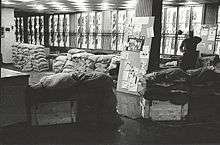
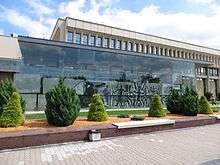
- 00:00 – Another column of military vehicles (including tanks and BMPs) is spotted leaving the military base and heading toward the TV tower.
- 01:25 – Upon arrival in the vicinity of the TV tower, tanks start to fire blank rounds. This causes many nearby windows to shatter and lifelong hearing loss or deafness in some of the protesters.
- 01:50 – Tanks and soldiers encircle the TV tower. Soldiers fire live ammunition overhead and into civilian crowds gathered around the building. Tanks drive straight through lines of people. Fourteen people are killed in the attack, most of them shot and two crushed by tanks. One Soviet Alfa unit member (Viktor Shatskikh) is killed by friendly fire. Loudspeakers on several BMPs transmit the voice of Juozas Jermalavičius: "Broliai lietuviai, nacionalistų ir separatistų vyriausybė, kuri priešpastatė save liaudžiai, nuversta. Eikite pas savo tėvus, vaikus!" ("Brother Lithuanians! The nationalist and separatist government, which confronted the people has been overthrown! Go [home] to your parents and children!")
- 02:00 – BMPs and tanks surround the Radio and Television Committee building. Soldiers fire live ammunition into the building, over the heads of the civilian crowds. The live television broadcast is terminated. The last pictures transmitted are of a Soviet soldier running toward the camera and switching it off.
- 02:30 – A small TV studio from Kaunas came on air unexpectedly. A technician of the family program that usually broadcast from Kaunas once a week was on the air, calling for anyone who could help to broadcast to the world in as many different languages as possible about the Soviet army and tanks killing unarmed people in Lithuania. Within an hour, the studio was filled with several university professors broadcasting in several languages. The small studio in Kaunas received a threatening phone call from the Soviet army division of Kaunas (possibly the 7th Guards Airborne Division of the Soviet Airborne Forces). By 4 in the morning, this studio received the news that a Swedish news station finally saw the broadcast and would be broadcasting the news to the world. The second phone call from the Soviet army division followed shortly, with a commander stating that "they would not try to take over the studio so long as no misinformation is given". This was all broadcast live. The Kaunas TV station was using Juragiai and Sitkūnai transmitters as retranslators.
.jpg)
Following these two attacks, large crowds (20,000 during the night, more than 50,000 in the morning) of independence supporters gathered around the Supreme Council building. People started building anti-tank barricades and setting up defences inside surrounding buildings. Provisional chapels were set up inside and outside the Supreme Council building. Members of the crowd prayed, sang and shouted pro-independence slogans. Despite columns of military trucks, BMPs and tanks moving into the vicinity of the Supreme Council, Soviet military forces retreated instead of attacking.
The events of 13 January are sometimes referred to as Bloody Sunday.[6] Among the members of the barricade were two basketball players who would later play for the Lithuanian national team, Gintaras Einikis and Alvydas Pazdrazdis.[7]
List of victims
.jpg)


In all, thirteen Lithuanians were killed by the Soviet army. An additional civilian died at the scene due to a heart attack, and one Soviet soldier was killed by friendly fire. All victims, except the soldier, were awarded the Order of the Cross of Vytis (the Knight) on January 15, 1991.
- Loreta Asanavičiūtė (b. 1967) – the only female victim. Worked as a seamstress in a factory. Died in hospital after she fell under a tank. Noted for her shy character, she became the most famous victim.
- Virginijus Druskis (b. 1969) – student at Kaunas University of Technology. Was shot in the chest.
- Darius Gerbutavičius (b. 1973) – student at a vocational school. Was shot five times (legs, arms and back).
- Rolandas Jankauskas (b. 1969) – student. He was hit in the face by an explosive device. His mother was a native Russian from Altai Krai.
- Rimantas Juknevičius (b. 1966) – native of Marijampolė, senior at Kaunas University of Technology. He was shot.
- Alvydas Kanapinskas (b. 1952) – worker at a Kėdainiai biochemical factory. He was shot.
- Algimantas Petras Kavoliukas (b. 1939) – butcher at a grocery store. He was wounded by a rubber bullet on January 11, 1991, when he protested against the Soviet troops near the Press House. On January 13, he was hit by a tank. According to some witnesses, he was the first victim killed that night.
- Vytautas Koncevičius (b. 1941) – shopman. Died in the hospital about a month after the attacks. Had been deported to Siberia with his family in 1945. He was shot.
- Vidas Maciulevičius (b. 1966) – locksmith. Died from bullet wounds to the face, neck and spine.
- Titas Masiulis (b. 1962) – Kaunas resident who was shot in the chest.
- Alvydas Matulka (b. 1955) – Rokiškis resident who died from a heart attack.
- Apolinaras Juozas Povilaitis (b. 1937) – metalworker at an institute. He died from bullet wounds to the heart, right lung, upper arm and thigh.
- Ignas Šimulionis (b. 1973) – high school student, a friend of Gerbutavičius. Was shot in the head.
- Vytautas Vaitkus (b. 1943) – plumber at a meat plant. Died from bullet wounds to the chest.
- Viktor Viktorovich Shatskikh (b. 1961) – Lieutenant Group 'A' Service Office MTO 7 of the KGB. Mortally wounded by a 5.45 mm bullet passing through a slit in his body armour (died from a ricochet bullet shot by a fellow soldier inside the Lithuanian National Radio and Television building). He was awarded the Order of Red Banner posthumously.
12 of the 14 victims were buried in the Antakalnis Cemetery in Vilnius. Titas Masiulis was buried in Petrašiūnai Cemetery in his native Kaunas, Rimantas Juknevičius was buried in the Marijampolė cemetery.
Aftermath
.jpg)
Immediately after the attacks, the Supreme Council issued a letter to the people of the Soviet Union and to the rest of the world denouncing the attacks and calling for foreign governments to recognise that the Soviet Union had committed an act of aggression against a sovereign nation. Following the first news reports from Lithuania, the government of Norway appealed to the United Nations. The government of Poland expressed their solidarity with the people of Lithuania and denounced the actions of the Soviet army.
The reaction from the United States government was somewhat muted as the U.S. itself was heavily preoccupied with the imminent onset of Operation Desert Storm against Iraq and worried about possible wider consequences if they were to offend the Soviets at that critical juncture. President George H.W. Bush denounced the incident, but was notably careful not to criticize Gorbachev directly, instead directing his remarks at "Soviet leaders."
After the events, President Gorbachev said Lithuanian "workers and intellectuals" complaining of anti-Soviet broadcasts had tried to talk to the republic's parliament, but were refused and beaten. Then, he said, they asked the military commander in Vilnius to provide protection. Defense Minister Dmitry Yazov, Interior Minister Boris Pugo and Gorbachev all asserted that no one in Moscow gave orders to use force in Vilnius. Yazov said that nationalists were trying to form what he called a bourgeois dictatorship. Pugo said on national television that the demonstrators had opened fire first.[8]
During the following day, meetings of support took place in many cities (Kiev, Riga, Tallinn).
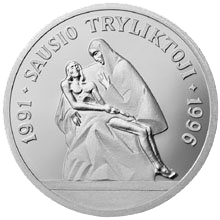
Although occupation and military raids continued for several months following the attacks, there were no large open military encounters after January 13. Strong Western reaction and the actions of Soviet democratic forces put the President and the government of the Soviet Union in an awkward position. This influenced future Lithuanian-Russian negotiations and resulted in the signing of a treaty on January 31.
During a visit by the official delegation of Iceland to Lithuania on January 20, Foreign Minister Jón Baldvin Hannibalsson said: "My government is seriously considering the possibility of establishing diplomatic relations with the Republic of Lithuania." Iceland kept its promise, and on February 4, 1991, just three weeks after the attacks, it recognized the Republic of Lithuania as a sovereign independent state, and diplomatic relations were established between the two nations.
These events are considered some of the main factors that led to the overwhelming victory of independence supporters in a referendum on February 9, 1991. Turnout was 84.73% of registered voters; 90.47% of them voted in favour of the full and total independence of Lithuania.
Streets in the neighbourhood of the TV tower were later renamed after 9 victims of the attack. A street in Titas Masiulis' native Kaunas was named after him, likewise a street in Marijampolė after its native, Rimantas Juknevičius, a street in Kėdainiai after Alvydas Kanapinskas, and a street in Pelėdnagiai (near Kėdainiai) after Vytautas Koncevičius.
The Russian Federation still claims that the Soviet troops did not use their weapons at all.
From the interview of Mikhail Golovatov, ex-commander of "Alpha-group": "The weapons and ammunition that were given to us, were handed over at the end of the operation, so it can be established that not a single shot was fired from our side. But at the time of the assault, our young officer Victor Shatskikh was mortally wounded in the back. As we have already seized the TV tower and went outside, we came under fire from the windows of the neighbouring houses, and leaving from there we had to hide behind the armoured vehicles."[9]
Legal proceedings
In 1996, two members of the Central Committee of Communist Party of Lithuanian SSR were sentenced to time in jail, Mykolas Burokevičius and Juozas Jermalavičius. In 1999 the Vilnius District Court sentenced six former Soviet military men who participated in the events. On May 11, 2011, a soldier of the Soviet OMON Konstantin Mikhailov was sentenced to lifetime in prison for killing customs workers and policemen in 1991 at the border checkpoint with Byelorussian SSR "Medininkai" near the village of Medininkai (see Soviet aggression against Lithuania in 1990).
Since 1992, representatives of the Prosecutor General Office of Lithuania requested Belarus to extradite Vladimir Uskhopchik, a former general who was in command of the Vilnius garrison in January 1991 and the editor of the newspaper "Soviet Lithuania" Stanislava Juonene.[10] Lithuania's request has constantly been denied. According to the Prosecutor General Office of Lithuania, during the entire period of investigation of the case, 94 requests for legal assistance were sent to Russia, Belarus, and Germany, but received only negative responses.
In July 2011, diplomatic tensions rose between Austria and Lithuania when Mikhail Golovatov, an ex-KGB general who took part in the January 13, 1991 massacre, was released after being detained at the Vienna Airport. He then proceeded to fly to Russia. In response, Lithuania recalled its ambassador from Austria.[11]
The Russian Federation refused to question the former president of the Soviet Union Mikhail Gorbachev on the petition of the Lithuanian prosecutors in connection with the January events of 1991.
Hearings in Vilnius Regional Court have started on January 27, 2016, with 65 individuals facing charges of war crimes, crimes against humanity, battery, murder, endangering other's well-being, as well as unlawful military actions against civilians.[12]
Defendants included ex-Soviet Defense Minister Dmitry Yazov, former commander of Soviet Alpha anti-terror group Mikhail Golovatov and Head of the Soviet Army's Vilnius garrison Vladimir Uskhopchik.
Robertas Povilaitis, a surviving son of one of the victims, requested that law enforcement authorities conduct an investigation into Mikhail Gorbachev's role in the events. On October 17, 2016, Vilnius Regional Court decided to summon Mikhail Gorbachev to testify as a witness.[13]
To this day, the Russian Federation refuses to extradite criminals against humanity that are responsible for the January Events.[14] Furthermore, in 2018 Russia's law enforcement even raised a case to the Lithuanian prosecutors and judges who investigate the case.[15]
Legacy
The Russian journalist Alexander Nevzorov recorded video footage commemorating Soviet spetsnaz who participated in the events and called it "Nashi".[4] Later in Russia appeared the Russian chauvinist political organization Nashi (not to be confused with later Nashi youth movement).
See also
References
- Lithuanians celebrate 20th Anniversary assault of the Vilnius television tower by the Soviet Troops. Ukrayinska Pravda. 13 January 2011
- "On This Day 13 January, 1991: Bloodshed at Lithuanian TV station". BBC News. Retrieved 2011-09-13.
- Helsinki Watch (Organization : U.S.) (1991). Glasnost in jeopardy: human rights in the USSR. Human Rights Watch. pp. 36, 37. ISBN 978-0-929692-89-0.
- Polishchuk, M. Lituanian, be free
- Keller, Bill (1991-01-14). "SOVIET CRACKDOWN; SOVIET LOYALISTS IN CHARGE AFTER ATTACK IN LITHUANIA; 13 DEAD; CURFEW IS IMPOSED". New York Times. Retrieved 2009-12-18.
The military takeover was preceded by five days of protests and strikes involving primarily Soviet and Polish workers at Vilnius manufacturing plants, angered by what they consider ethnic discrimination and by the Lithuanian government's move to increase prices on consumer goods.
- "Akmenės rajono spauda apie 1991 m. sausio įvykius" (in Lithuanian). laisve15.lt. Archived from the original on 2011-07-22. Retrieved 2011-09-13.
- Victory On The Court, Triumph In The Eyes Finishing Third In Men's Basketball Is Worth More Than A Bronze Medal To Lithuania.
- KREMLIN `DID NOT ORDER TROOPS TO USE FORCE'; Seattle Post – Intelligencer. Jan 14, 1991. pg. a.1
- 'Альфе' – 30 лет. Military-industrial courier (in Russian) (28 (45)). 28 July 2004. ISSN 1729-3928.
- Belarusian prosecutors: Uskhopchik can’t be extradited, he defended the Soviet Union. Charter'97 :: News from Belarus. 5 January 2010
- Lithuania recalls ambassador from Austria amid legal dispute. Hürriyet Daily News. 18 July 2011
- "Ex-USSR president Gorbachev may be questioned over 1991 crimes in Lithuania - report". RAPSI. Retrieved 2016-12-02.
- "Lithuanian Court To Summon Gorbachev To Trial Over 1991 Soviet Crackdown". RadioFreeEurope/RadioLiberty. Retrieved 2016-12-02.
- "Russia's taking revenge on Lithuania with its Jan 13 judge probe, formin says". www.baltictimes.com. Retrieved 10 April 2019.
- "Rusijos tyrimų komitetas iškėlė baudžiamąją bylą Lietuvos prokurorams ir teisėjams". DELFI.lt. Retrieved 23 July 2018.
External links
| Wikimedia Commons has media related to January Events (Lithuania). |
- (in Lithuanian) www.laisve15.lt – portal dedicated to 15th anniversary of massacre.
- www.lrs.lt – collection of photo, video and other testimonies.
- "On This Day 13 January, 1991: Bloodshed at Lithuanian TV station". BBC News.
- Loreta Asanavičiūtė’s Story
- (in Ukrainian) Russia refused to question the former president of Soviet Union
- (in Ukrainian) Polishchuk, M. Lithuania, be free! Recollections of a student defense squad participant in the 1991 Winter Vilnius events. Ukrayinska Pravda. 18 January 2011
